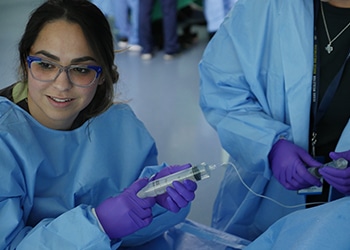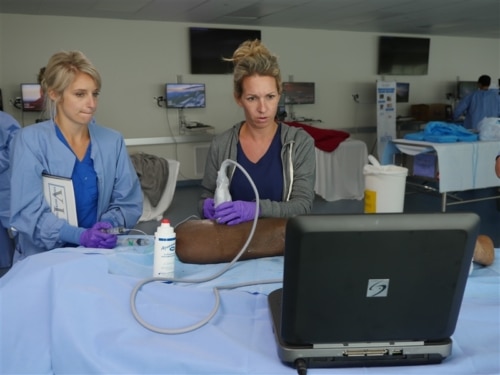-
 Earn 14 Class A AANA Continue Education hours This online USGRA program (Essential Techniques), includes instruction for the following nerve blocks:
Earn 14 Class A AANA Continue Education hours This online USGRA program (Essential Techniques), includes instruction for the following nerve blocks:- Axillary
- Adductor Canal
- Fascia Iliaca
- Femoral
- Popliteal Plexus
- Popliteal Sciatic
- Supraclavicular/Interscalene
- It also includes modules on the physics of ultrasound and the implementation of a Postoperative Pain service
-
 Maverick Medical Education offers the only nerve block CE course with high-fidelity pulsatile cadaver training, allowing students to actually perform all blocks taught. Students must complete the online pre-learning modules before attending the proficiency lab. Blocks Taught
Maverick Medical Education offers the only nerve block CE course with high-fidelity pulsatile cadaver training, allowing students to actually perform all blocks taught. Students must complete the online pre-learning modules before attending the proficiency lab. Blocks Taught- Interscalene
- Supraclavicular
- Axillary
- Adductor Canal
- PENG/LFCN
- Femoral
- Popliteal Sciatic
- Popliteal Plexus
-

Prerequisite for Advanced Regional Anesthesia: Student must be proficient in basic ultrasound-guided regional anesthesia.
Designed for students already familiar with the use of ultrasound and regional nerve blocks, the Advanced Regional Anesthesia course builds on nerve block skills and adds six additional blocks to your regional anesthesia training along with the addition of catheter placement and management.
Once students feel confident in their proficiency of the material, they will test their knowledge with instructors. Upon successful completion of course requirements, each student earns a Certificate of Proficiency.
Blocks Taught- Erector Spinae
- Paravertebral
- PECs 1 and 2
- Quadratus Lumborum
- Suprascapular
- TAP
-
 Using Maverick's proven learning process developed by experts in education and utilizing the "flipped classroom", students learn at their own pace and at their convenience. The online didactic program consists of 8 modules that guide you through the foundational knowledge necessary for the hands-on lab.
Using Maverick's proven learning process developed by experts in education and utilizing the "flipped classroom", students learn at their own pace and at their convenience. The online didactic program consists of 8 modules that guide you through the foundational knowledge necessary for the hands-on lab.Online modules include:
- Introduction to ultrasound including a brief history of US development and the physics of how the US works to produce an image on the screen.
- POCUS for Gastric Assessment
- POCUS for peripheral vascular access
- POCUS for Internal Jugular access
- Cardiac assessment for normal cardiac function and commonly seen pathological conditions
- Pulmonary assessment for normal function and common problems.
- eFast assessment for trauma and hemodynamically unstable patients
- POCUS for DVT assessment
-
 Point of Care Ultrasound (POCUS) assessment is fast becoming an integral way to make a fast and accurate assessment of patients for clinical decision-making. It is performed at the bedside and has been proven to be accurate and repeatable for serial assessments of unstable patients to help guide their care. Some have stated that "ultrasound will soon replace the stethoscope". This course teaches CRNAs, nurse practitioners, physician assistants, physicians, and other allied health professionals the crucial skill of point-of-care ultrasound (POCUS) as an assessment tool. Using Maverick's proven learning process developed by experts in education and utilizing the "flipped classroom", students learn at their own pace and at their convenience. The online didactic program consists of 8 modules that guide you through the foundational knowledge necessary for the hand's-on lab. Following completion of the online didactic modules, students then attend a 1-day, hands-on lab where they scan live models and practice vascular access techniques on gel phantoms with low student-to-instructor ratios. Online modules include:
Point of Care Ultrasound (POCUS) assessment is fast becoming an integral way to make a fast and accurate assessment of patients for clinical decision-making. It is performed at the bedside and has been proven to be accurate and repeatable for serial assessments of unstable patients to help guide their care. Some have stated that "ultrasound will soon replace the stethoscope". This course teaches CRNAs, nurse practitioners, physician assistants, physicians, and other allied health professionals the crucial skill of point-of-care ultrasound (POCUS) as an assessment tool. Using Maverick's proven learning process developed by experts in education and utilizing the "flipped classroom", students learn at their own pace and at their convenience. The online didactic program consists of 8 modules that guide you through the foundational knowledge necessary for the hand's-on lab. Following completion of the online didactic modules, students then attend a 1-day, hands-on lab where they scan live models and practice vascular access techniques on gel phantoms with low student-to-instructor ratios. Online modules include:- Introduction to ultrasound including a brief history of US development and the physics of how the US works to produce an image on screen.
- POCUS for Gastric Assessment
- POCUS for peripheral vascular access
- POCUS for Internal Jugular access
- Cardiac assessment for normal cardiac function and commonly seen pathological conditions
- Pulmonary assessment for normal function and common problems.
- eFast assessment for trauma and hemodynamically unstable patients
- POCUS for DVT assessment
-
 Course III is for those who have completed Courses I & II and/or are experienced in fluoroscopy-guided pain interventions but wish to add ultrasound-guided interventions to their skillset and learn the all-important business of pain management. Online topics covered:
Course III is for those who have completed Courses I & II and/or are experienced in fluoroscopy-guided pain interventions but wish to add ultrasound-guided interventions to their skillset and learn the all-important business of pain management. Online topics covered:- Using Ultrasound in Pain Management: Injections for major and minor joints; various peripheral nerves.
- Pain Management in Rural Settings
- The Business of Pain Management


